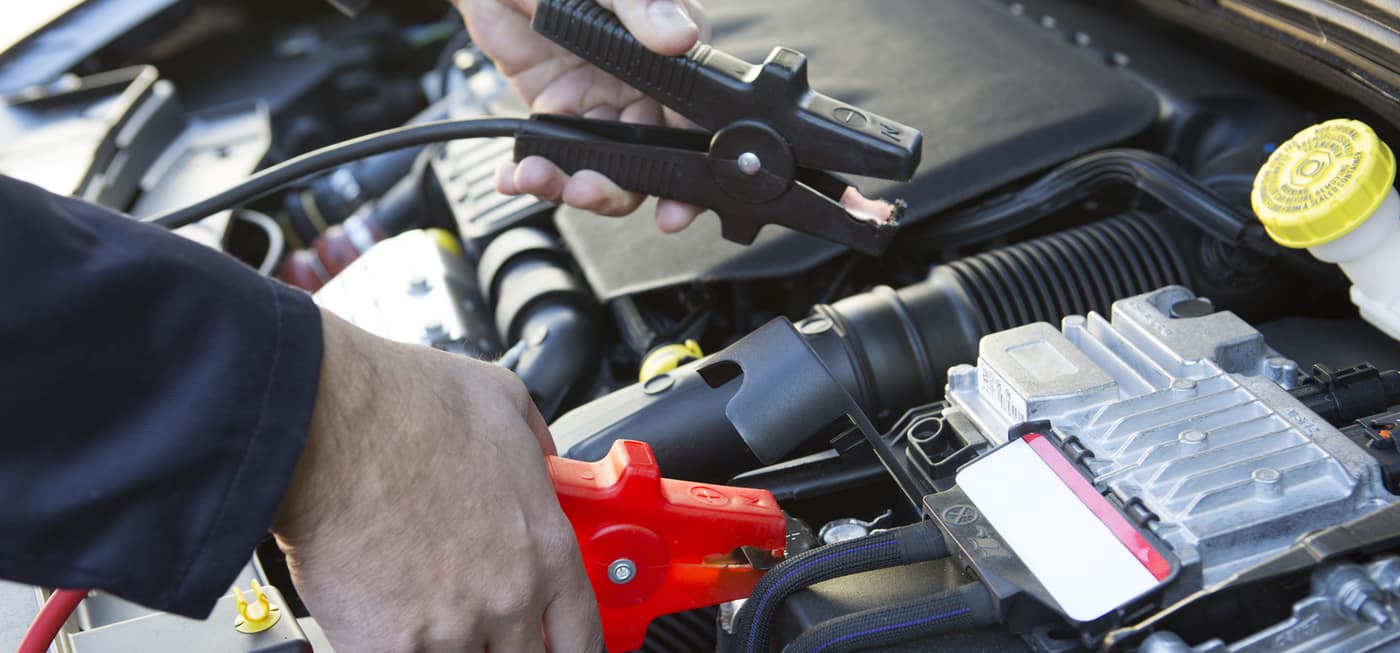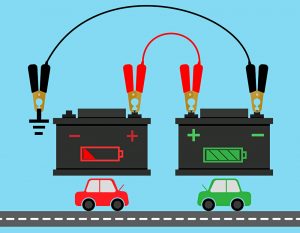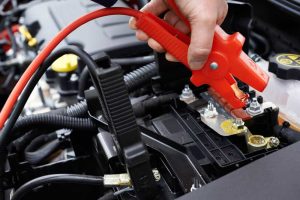

Have you ever been in a rush, jumped in the driver’s seat of your car, turned the key, and gotten ready to drive away —but as you turn your ignition, nothing happens? A few clicks or sputters of your engine, maybe. But other than that, nothing. Luckily, you are well-prepared and keep emergency equipment in your trunk—including jumper cables! You have the tools to bring your car back to life, but as you stare at these cables, you are unsure how to properly use them. Though having the right emergency equipment is a great start, jump-starting a car is not something everyone learns how to do. In this article, we have listed what you need to know about how to jump a car. A few simple steps and you are at your destination on time!
What Do You Need to Jump-Start a Car?
First, you need a few basics:
1. Jumper cables
2. Power source – either a portable jump battery (or jump box) or another vehicle

Jumper cables are thickly insulated cables with clips on one or both ends. These clips are called alligator clips (because they look like alligator heads). The clips are distinguished by color, usually red and black, to indicate the positive and negative ends. The red clip is positive. The black clip is negative. Jump boxes are portable batteries used to jump-start a vehicle without connecting to another vehicle. These cables connect the jump battery directly to the dead car battery. Roadside assistance usually uses a jump box when helping revive dead batteries.
What You Need to Know About Car Batteries to Jump-Start a Car
Car batteries have two larger nubs, called terminals. There is a positive terminal and a negative terminal. Each should be clearly marked. Connecting the cables to the right terminal is crucial to complete the circuit and give the dead battery power. Connect the positive clamp to the positive terminal and the negative clamp to the negative terminal. Then do the same to the jump box.

Steps to Hook Up Jumper Cables to Jump Start a Car from Another Vehicle:
1. Check Batteries: Make sure that the battery giving the jump has enough voltage and is a matching voltage system type (12V, 6V, etc).
2. Ready Cars: Put both cars in park or neutral, turn the ignitions off, and put on the parking brake. Make sure cars are in the right distance to have the jumper cables reach each battery. Pull the cars so that they are aligned either nose-to-nose or side-by-side.
3. Open the Hood of each car.
4. Attach Alligator Clips to the terminals in the following order:
Red to Dead – Connect red, or positive, clip to the positive terminal on the battery of the dead car.
Red to Donor – Connect the red, positive, clip to the positive terminal on the donor battery on the other car.
Black to Donor – Connect the black clip to the negative terminal of the donor car.
Black to Metal – Connect the black clip to an unpainted metal part of the dead car that is not directly next to the battery. One of the metal struts that hold the hood open is a good place to clip the second black, or negative, clip.
5. Start the Donor Car so that the battery can supply power to the dead battery.
6. Idle the donor car, allowing it to run for a few minutes.
7. Test the interior light of the car being jump-started. If it goes on, there may be enough power.
8. Start the dead car.
After the car is jumped, unclip the clips in the reverse order you connected them and allow the car to run without stopping for a minimum of 10-20 minutes.
To Ensure that the Car Donating a Charge is Protected, Take These Precautions:
1. Match the kind of voltage system of the donor battery to the dead battery to be jumped. For example, a 6V and a 12V should not be used together.
2. Connect alligator clips in the right order as listed above.
3. Make sure the donor battery is not low.
4. Be sure that the car giving the jump start’s headlights are steady and bright when the car is started. If the headlights dim, that can signal that the battery is low.
Cautions When Jump-Starting a Car:
1. Read the Owners Manual. Some cars are not recommended for jump-starting because they have sensitive circuitry
2. Do Not Jump corroded, cracked, leaking, or visibly damaged batteries, frozen batteries, or dry batteries
3. Do Not Touch Clips together.
What if the Car Doesn’t Start After the Jump or Hold a Charge?
If the dead car doesn’t start after a few minutes of being powered then check the connections and repeat or try starting the car again. If the car does not start after several attempts, the battery may be too far gone to be jump-started.
The Causes of a Failed Charge
- First, it may be that the terminals on your car battery need a deep cleaning.
- Your battery may be very old, and beyond the point at which it can be repaired—in which case, it will need to be replaced.
- Finally, note that there could be another mechanical problem somewhere in the vehicle, such as blown fuses or a bad alternator. A Luke’s Auto Service technician can help diagnose and fix any of these problems!
How to Prevent Your Battery from Dying
Of course, it’s optimal to take precautionary measures to keep your battery from dying at all. This isn’t always possible because eventually, all batteries die out—but there are some things you can do to prolong your battery life for as long as possible.
- Make sure you make regular battery tests part of your routine maintenance. When you take your vehicle to Luke’s for an oil change and tire rotation, also have us check the battery life, and let you know when it’s time to think about a replacement.
- Protect your battery from extreme weather. Put your vehicle in a garage during the winter or summer, whenever possible. If it’s not possible, consider an insulated blanket to keep your battery safe.
- If you’re going out of town and won’t be driving the car for a few weeks, see if a family member or friend can start it and drive it around the block once or twice, ensuring the battery stays charged.
- You’ll also want to double-check to be sure you aren’t leaving lights or appliances on when the vehicle isn’t running as these are major drains on the battery life.
Battery life is something you can extend through regular, preventative maintenance. To schedule an appointment for a battery test, click the button below and we will be happy to help you keep your vehicle battery in great working order!
References & Image Credit:

